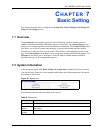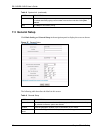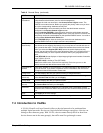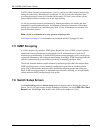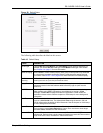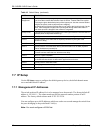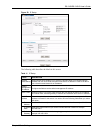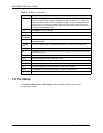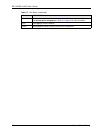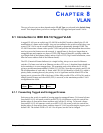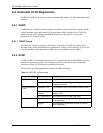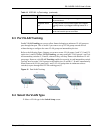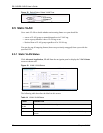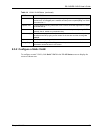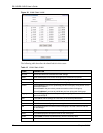
ES-2108/ES-2108-G User’s Guide
Chapter 7 Basic Setting 65
Figure 30 Port Setup
The following table describes the labels in this screen.
Table 12 Port Setup
LABEL DESCRIPTION
Port This is the port index number.
Active Select this check box to enable a port. The factory default for all ports is enabled. A
port must be enabled for data transmission to occur.
Name Enter a descriptive name that identifies this port.
Type This field displays 10/100M for an Ethernet connection and 1000M for the Gigabit
Ethernet/ mini-GBIC ports.
Speed/Duplex Select the speed and the duplex mode of the Ethernet connection on this port.
For Ethernet ports, select Auto, 10M/Half Duplex, 10M/Full Duplex, 100M/Half
Duplex or 100M/Full Duplex.
For the Gigabit Ethernet/mini-GBIC port, select Auto, 100M/Full Duplex or 1000M/
Full Duplex.
Selecting Auto (auto-negotiation) allows one port to negotiate with a peer port
automatically to obtain the connection speed and duplex mode that both ends support.
When auto-negotiation is turned on, a port on the switch negotiates with the peer
automatically to determine the connection speed and duplex mode. If the peer port
does not support auto-negotiation or turns off this feature, the switch determines the
connection speed by detecting the signal on the cable and using half duplex mode.
When the switch’s auto-negotiation is turned off, a port uses the pre-configured speed
and duplex mode when making a connection, thus requiring you to make sure that the
settings of the peer port are the same in order to connect.
Flow Control A concentration of traffic on a port decreases port bandwidth and overflows buffer
memory causing packet discards and frame losses. Flow Control is used to regulate
transmission of signals to match the bandwidth of the receiving port.
The switch uses IEEE802.3x flow control in full duplex mode and back-pressure flow
control in half duplex mode.
IEEE802.3x flow control is used in full duplex mode to send a pause signal to the
sending port, causing it to temporarily stop sending signals when the receiving port
memory buffers fill.
Back Pressure flow control is typically used in half duplex mode to send a "collision"
signal to the sending port (mimicking a state of packet collision) causing the sending
port to temporarily stop sending signals and resend later. Select Flow Control to
enable it.



